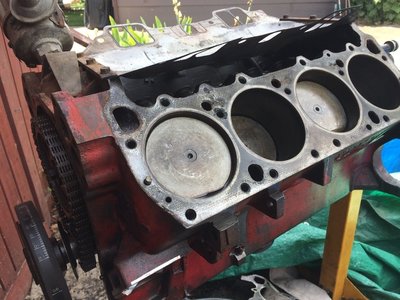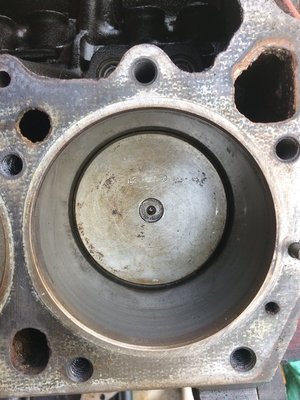If you are working with a person who is using a belt sander to clean the gasket surfaces, you are working with someone who doesn't really know what they are doing. That is as polite as I can get.
There are several books available on building the Chrysler big block engines and you should get and read one before you go any further.
If I could agree with IQ52's statement TEN times I would have, but I can only click on one green "agree" button. "Belt-Sander-Boy" is a complete idiot that is ruining your engine & costing you a lot of money.
To clean the head/block mating surfaces, I use a scraper VERY, VERY gingerly to just remove the gasket pieces & not scratch those surfaces....I'm sure there's an even gentler way. It is critical to have those surfaces perfectly smooth so your head gaskets will seal.
You want to spray down the cylinders with WD-40 (not acetone). The WD-40 just prevents air/moisture from nearly instantly rusting (& ruining) the cylinder bores. I mean, you "could" use acetone to clean it, but follow that up IMMEDIATELY with WD-40 (or motor oil) to just prevent "flash rust".
One way I've done it is to turn the motor over a tiny bit to see which cylinders are headed down. Do your gasket removal/cleaning process on those two cylinders (2 go down at a time), spray with a touch of WD-40 so all the dirt/smutz you just created sticks to the cylinder wall/piston, turn the engine (crank bolt) a bit more, piston moves down, wipe of dirt/smut & repeat. When you do it this will all make sense. You just don't want to have all that dirt/smutz scraping the sides of the cylinders/piston rings. Once a cylinder (or two if cleaning in pairs) is done, immediately re-spray WD-40 to prevent rust.
Also, like 65-440 says, you are literally about a dozen bolts away from a complete rebuild. If you don't have cash for that (I've been there), then at least pop off the main caps (re-torque when done) and rod caps (re-torque when done).... don't switch caps & keep them facing the same direction. Doing this you can inspect the bearings (i.e. good bearings = good oil pressure = long engine life) and if you find any of them scratched up, NOW is the time to replace them. For the pistons/rings...the old "rule of thumb" is that if you can't get a fingernail on the "wear lip" at the top of each cylinder, you can get by without putting new pistons/rings in. (good piston/ring seal = good power). If one/two is bad, now would be the time to re-hone & re-ring those cylinders.
My first engine build was one broken piston (not too bad). I didn't "machine" anything. I bought ONE stock piston & honed that cylinder + two others, but new rings in just those three cylinders & put in a new set of rod/main bearings without machining the crank. It was a "poor-man's rebuild" 383 and I drove it like that for another 3 years & it was still running good when I pulled it out (for a larger, completely rebuilt motor).
Obviously, if you have the cash.... rebuild the whole motor....now is the time.
This is also a good time to change the timing chain, ESPECIALLY if the teeth on your top gear are plastic (some plastic/some steel)





 .
.














